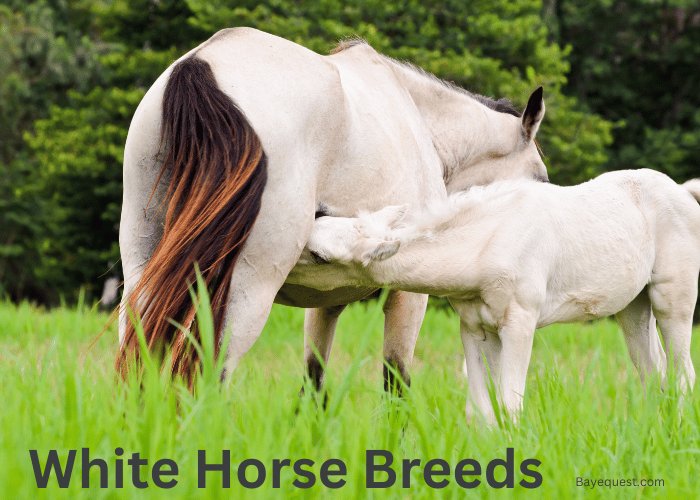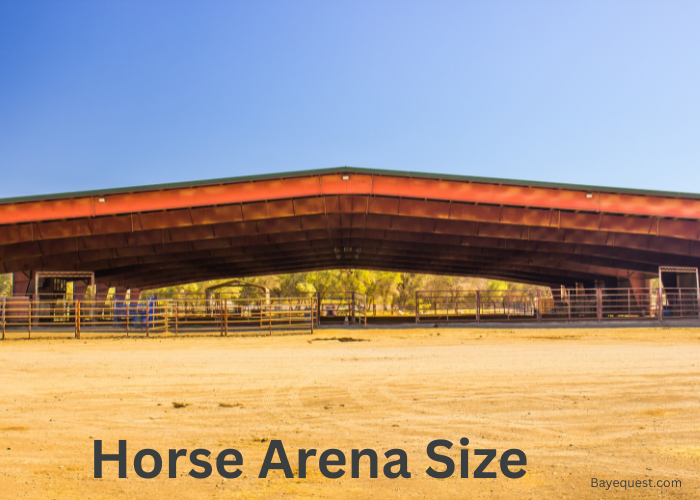White horses have always caught our eye and sparked our imaginations. They’re not just beautiful; they carry stories and myths from all around the world.
This blog is all about those stunning white horse breeds. We’ll dive into their unique genetics, the different types of white horses out there, and their rich histories.
So, let’s explore the fascinating world of white horse breeds together.
Types of White Horses: Key Takeaway
- Camarillo White Horse
- American Quarter Horse
- Lipizzan
- Camargue horse
- American Cream Draft
- Boulonnais horse
- Cheval crème
- Carthusian
- Orlov Trotter
- Percheron
- Shagya Arabian Horse
- Blazer Horse
- American Paint Horse
- Cremello Horse
- Clydesdale Horse
- Azteca Horse
- Mustang Horse
- Missouri Fox Trotter Horse
- Connemara Pony
- Tennessee Walking Horse
What is a True White Horse?
A true white horse is pretty special. It’s not just any light-colored horse. What makes it truly white is its coat from the start – pure white.
This isn’t about getting whiter as they grow older, like grey horses do. They’re born white and stay that way their whole life. And it’s not just the coat. Their skin underneath? Also white.
Even their eyes have a unique touch, often blue, setting them apart. The magic behind this stunning look is all in their genes. It’s rare, making these horses stand out in the crowd.
So, when you see a horse that’s white all over, from its coat to its eyes, you’re looking at a true white horse.
How are White Horse Breeds Classified?
White horse breeds are classified not just by their stunning coats, but by their genetics. You see, not all white horses are alike.
Some are born with that snowy coat because of specific genes. These genes make them true white horses, which are pretty rare.
Other horses might look white, but they’re actually light gray, cream, or have other coat patterns that fade to white as they grow older.
When we talk about classifying white horse breeds, we look at their heritage, where they come from, and the specific genetic traits that give them their color.
For example, some breeds have a dominant white gene, which is what makes them truly white from birth, without changing as they age. Other breeds might have patterns or markings that include white but aren’t considered true whites.
So, in short, classifying white horse breeds involves looking at their genetics, the color they are when they’re born, and how that color might change as they get older.
It’s a fascinating mix of science, history, and a bit of mystery, all wrapped up in the beauty of these remarkable animals.
White Horse Breeds
Here are some of the white horse breeds in the world:
1. Camarillo White Horse
The Camarillo White Horse comes from California, starting in the early 1920s. Adolfo Camarillo bred them, starting with a stallion named Sultan.
These horses have pure white coats, which they have from birth, thanks to specific genetics. They were bred for parades and shows, standing out with their bright white color and graceful movements.
Their prices can vary widely but expect to pay a premium for their rare beauty and lineage. Their exact shade of white is often described as “brilliant” or “gleaming,” making them a favorite for public appearances.
2. American Quarter Horse
American Quarter Horses aren’t typically known for being white. They come in various colors, but some can appear white due to specific genetic traits.
Originating from the 17th century in the USA, they’re bred for their speed over short distances. The “white” ones you see might be very light.
Their versatile nature makes them popular for both work and leisure.
3. Lipizzan
Lipizzans originate from the Habsburg monarchy, bred for the Spanish Riding School of Vienna in the late 16th century. Though they’re born dark, they turn white as they mature, a trait that’s fascinated many.
This breed is famous for its classical dressage skills, showcasing incredible agility and strength.
Prices for a Lipizzan can be high, especially for those trained in dressage. Their coat transitions to a stunning, gleaming white, embodying elegance and power.
4. Camargue horse
Native to the Camargue region in France, these horses are wild and rugged. Born with a dark coat, they gradually turn white as they grow. With their stamina and hardiness, they’ve roamed free for centuries.
Camargue horses are not just about their looks. They’re bred for their ability to navigate the marshy Camargue lands.
Their prices aren’t as steep as other breeds, given their wild status, but their enduring spirit is priceless. Their shade of white, once fully matured, blends perfectly with the marshes they call home.
5. American Cream Draft
The American Cream Draft is the only draft horse breed originating in the United States. It has a cream color and amber eyes.
This breed was started in the early 20th century in Iowa, and its numbers are limited, making it quite rare. Breeding focused on creating a strong, versatile draft horse with a distinctive cream coat.
Their coat’s exact shade can range from a light cream to a rich, deep cream, highlighting their gentle nature and strength.
6. Boulonnais horse
The Boulonnais horse, known as the “White Marble Horse,” hails from France. This breed’s history stretches back to ancient times, with its numbers dwindling significantly by the end of World War II.
Bred for their strength and beauty, they were once war horses and are now often used in agriculture and meat production.
Due to their rarity and historical significance, their prices can be high. Their white coats shimmer like marble, a testament to their enduring elegance and power.
7. Cheval crème
The Cheval Crème is not a widely recognized breed but refers to horses with a cream coat, often found in breeds like the Crème Draft. These horses carry a specific gene that dilutes their base coat color to a creamy hue.
They are bred for this unique color, among other traits. Prices vary based on breed and purpose. Their exact shade of white, tinged with cream, gives them a soft, warm appearance unlike the stark whites of other breeds.
8. Carthusian
Carthusians are one of the oldest strains of the Andalusian horse, dating back to the 15th century in Spain. They are known for their pure Spanish lineage, preserved by Carthusian monks.
While not all are white, those that are, exhibit a striking, luminous coat. Bred for their grace and agility, Carthusians are highly prized, with prices reflecting their prestigious heritage.
Their white coats, when they occur, are prized for their rarity and beauty.
9. Orlov Trotter
Originating in Russia in the late 18th century, the Orlov Trotter is known for its speed, stamina, and, in some, a striking white coat. Count Orlov developed this breed for both harness racing and as a riding horse.
While not all Orlovs are white, those that are, command attention with their elegant appearance. Their breeding focused on creating a fast, durable horse, impacting their price based on performance capabilities.
Read also: Fast horses in the world.
10. Percheron
The Percheron hails from France. They are known for their strength and elegance. Originating in the Perche valley, they were once war horses.
Now, they are popular for farming and pulling carriages. While not all are white, those that are, showcase a stunning, pure white coat. They’re big, friendly giants with a calm demeanor.
11. Shagya Arabian Horse
The Shagya Arabian, developed in the Austro-Hungarian Empire, is a refined version of the traditional Arabian. They are however enhanced with larger size and strength for cavalry use.
These horses often boast a shimmering white coat, embodying elegance and endurance. Renowned for their versatility, Shagya Arabians excel in both competitive and recreational equestrian activities.
Interesting read: What is the cost of Arabian Horses?
12. Blazer Horse
The Blazer Horse, an American breed founded in the mid-20th century, is celebrated for its intelligence, strength, and friendly nature. Blazers are adaptable, excelling in various disciplines from trail riding to competitive sports.
Though their coats come in many colors, including white, they are particularly noted for their compact build and amiable disposition.
13. American Paint Horse
The American Paint Horse is distinguished by its striking color patterns. It combines white with other hues in unique configurations.
Originating from the American West, this breed is valued for its beauty, temperament, and versatility. The presence of white in their coat, whether as overo, tobiano, or tovero patterns, adds to their eye-catching appeal.
Learn about American Paint Horse Cost in our comprehensive guide.
14. Cremello Horse
Cremello horses, recognized by their cream coat, blue eyes, and pink skin, result from the presence of two cream dilution genes.
This coloration can occur in many breeds, giving the Cremello its distinct, ethereal appearance. Beyond their stunning looks, Cremellos are appreciated for their gentle nature.
15. Clydesdale Horse
The Clydesdale, originating from Scotland, is a breed known for its substantial size, feathered feet, and gentle demeanor. While traditionally bay, black, or brown, white Clydesdales are rare and captivating. (Find out the brown horse breeds in the world.)
These horses are celebrated not only for their striking appearance but also for their strength and friendly personalities.
16. Azteca Horse
The Azteca Horse is a symbol of Mexican heritage. It was created through the crossbreeding of Andalusian, Quarter Horse, and Mexican Criollo.
This breed stands out for its agility, beauty, and versatility in disciplines such as dressage and bullfighting. White Aztecas, though less common, dazzle with their elegant coats and graceful movements.
17. Mustang Horse
Mustangs, the iconic wild horses of the American West. They symbolize rugged independence and freedom.
These horses come in a variety of colors, including white, which stands out in the vast landscapes they roam. White mustangs, with their resilient nature, are a testament to the enduring spirit of the West.
18. Missouri Fox Trotter Horse
The Missouri Fox Trotter, originating from the Ozark region, is celebrated for its unique gait. While they come in various colors, white Missouri Fox Trotters, although less common, exhibit a striking beauty with their pure, gleaming coats.
Bred for both their endurance and their gentle disposition, these horses are favored by trail riders and show competitors alike for their versatility and comfort.
19. Connemara Pony
The Connemara Pony, hailing from the rugged landscapes of Western Ireland, is renowned for its athleticism, versatility, and kind nature. This breed, the largest of the pony breeds, excels in jumping and endurance.
Connemaras display a range of coat colors, including white, which highlights their spirit. Their resilience and adaptability can be traced back to their origins, thriving in the harsh Irish climate.
20. Tennessee Walking Horse
The Tennessee Walking Horse is famed for its distinctive running walk. Originating in the Southern United States, this breed was developed for plantation owners.
While their coats can be of any color, including white, it’s their graceful movement and friendly personality that truly define the breed.
White Tennessee Walking Horses captivate with their serene appearance, complementing their reputation for being gentle and reliable companions.
Roles of White Horses in the Society
White horses have held a special place in societies around the world. Not just for their striking looks but for the roles they’ve played across history and culture. Let’s talk about a few of these roles.
First off, white horses often appear in ceremonies and parades. Their bright color and majestic presence add a touch of elegance and solemnity to events.
In movies and TV shows, white horses often show up as the noble steeds of heroes. Their pure and striking appearance helps symbolize the goodness and bravery of the characters who ride them.
White horses also have a place in therapy and healing. Their calm and gentle nature makes them perfect for therapeutic riding programs.
In folklore and mythology, white horses are symbols of purity, victory, and transformation. They’re the mounts of gods and heroes, carrying them through battles and adventures.
Lastly, white horses stand as a symbol of beauty and rarity in the animal world. They remind us of the wonder of nature and the special bond between humans and horses.
Shortcomings of White Breed Horses
White horses, while stunning, face some challenges unique to their coloring.
One big issue is sunburn. Just like people, horses with light skin, especially around their noses and eyes, can get sunburned. This means they need extra care, like sunscreen or protective clothing, when they’re out in the sun.
Another concern is their eyesight. Some white horses with blue eyes can be more sensitive to bright light. This doesn’t mean they can’t see well; it’s just something their owners need to be mindful of, maybe providing shade or shelters.
Genetic health issues can also pop up. Some conditions, like lethal white syndrome, are linked to the genetics that give horses their white coat. This doesn’t affect all white horses, but it’s something breeders try to avoid.
Keeping them clean is another task. White horses show dirt and stains much more than darker horses. So, they need more grooming to keep them looking sharp, especially if they’re show horses or used in ceremonies.
Lastly, there’s the risk of hearing problems. Just like with dogs and cats, some white horses with blue eyes might be deaf. It’s not super common, but it’s another thing that requires attention and special care.
Even with these challenges, white horses are loved and valued for their beauty and grace. It’s all about knowing what they need and giving them the right care.
Challenges of Breeding White Horses
Breeding white horses comes with its own set of hurdles.
First up, there’s the genetics puzzle. Getting a horse that’s truly white, not just light or gray as it ages, can be tricky. It’s all about understanding the genes and how they mix. Sometimes, breeders aim for one thing and get another because horse genetics can be complex and surprising.
Then, there’s the issue of health risks. Some genes that make horses white can also bring health problems. Breeders have to be careful to avoid passing on conditions that could affect the horse’s quality of life.
Keeping the bloodline pure while avoiding inbreeding is another challenge. With a limited number of true white horses, breeders have to work hard to keep the line going without causing health issues.
Also, there’s the market demand. White horses are rare and eye-catching, but breeding is more than just about color. Breeders have to consider the horse’s build, temperament, and abilities, making sure they’re not sacrificing quality for color.
Lastly, there’s the practical side of raising white horses. They can be harder to keep clean and more prone to sunburn, which means they need extra care and attention.
All in all, breeding white horses isn’t just about aiming for that stunning coat. It’s a careful balance of genetics, health, and practical care, all while keeping an eye on what horse lovers are looking for.
FAQs
Why is a white horse called gray?
A horse that looks white is often called gray because its coat is actually made up of hairs that are a mix of white and darker colors. As the horse ages, it may appear to become whiter because it loses more of the darker hairs. This graying process can start very early in life, but these horses aren’t born white. The term “gray” is used in the horse world to describe this color change over time.
What defines white horse breeds?
White horse breeds are defined by their ability to produce horses with coats that appear white. This can be due to specific genetic traits that result in a true white coat from birth, which is rare. True white horses have a completely white coat, white skin, and often blue or light-colored eyes, and they’re distinguished by their genetic makeup.
Are white horse breeds more prone to health issues?
Yes, white horse breeds can be more prone to certain health issues. For example, true white horses, or those with very light coats, can be more susceptible to sunburn and skin cancer due to their lack of pigment. Genetic conditions like lethal white syndrome, which affects some white foals, also affect white horses.
Are white horse breeds truly white?
Yes and no. Some horses are considered truly white, with pure white coats, white skin, and no pigmentation from birth. These true white horses are very rare. Most horses that appear white are actually gray, as they have a genetic predisposition to lose pigmentation in their coat as they age, leading to a white or very light appearance. The term “white” in horses often refers to their appearance rather than their actual color from birth.
White Horses Breed: Conclusion
In the end, white horses are like living legends, walking among us. They’re not just a pretty face; they carry history, mystery, and a touch of magic wherever they go.
Whether they’re born sparkling white or change as they grow, each one tells a story. They remind us of battles won, of kings and queens, and of myths that dance through our dreams.
So, the next time you see one, take a moment to watch how they move and how they carry themselves with grace. White horses aren’t just animals; they’re a piece of the puzzle that makes up our world’s beautiful picture.








